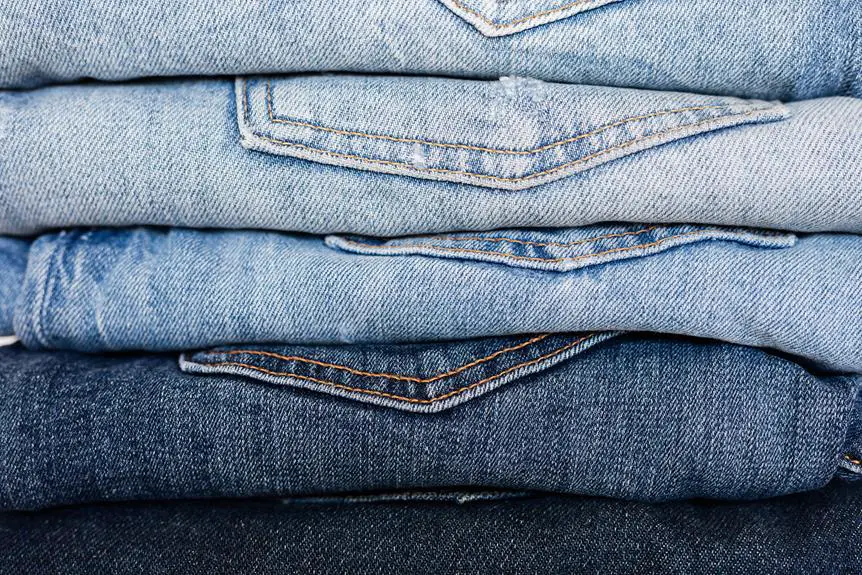If you're wondering which fabric paint is best for your clothing, there are several factors to consider.
Different types of fabric paint offer varying levels of color fastness, durability, and washability. For example, acrylic fabric paint is known for its versatility and ability to create bold, opaque designs on both natural and synthetic fabrics.
When making your choice, it's important to assess your desired application techniques, special effects, and finishes.
Additionally, take into account the safety and environmental impact of the fabric paint, as well as your budget.
By understanding these factors, you can make an informed decision to ensure your clothing projects turn out exactly as you envision.
Key Takeaways
- Consider factors such as color fastness, durability, washability, application techniques, safety, and environmental impact when choosing fabric paint for clothing.
- Acrylic fabric paint, water-based fabric paint, and oil-based fabric paint are common types of fabric paint to consider.
- Acrylic paint offers versatility and durability, while fabric paint has flexibility and is specifically designed for textiles.
- Water-based fabric paint dries quickly and is easy to clean up, while oil-based fabric paint offers longevity and resilience.
Factors to Consider
When choosing fabric paint for your clothing, durability should be your primary consideration. Fabric compatibility is crucial to ensure that the paint adheres well to the material and doesn't crack or peel after application. Different types of fabric paints are designed for specific materials, so it's important to select one that's compatible with the fabric of your clothing to achieve the best results.
Another important factor to consider is the drying time of the fabric paint. This is particularly vital if you need the clothing item for a specific event or occasion. Some fabric paints dry quickly, allowing you to complete your project in a shorter time frame, while others may require a longer drying time. Understanding the drying time of the fabric paint will help you plan your painting process effectively and ensure that your clothing is ready to wear when you need it.
Types of Fabric Paint
When choosing fabric paint, it's important to consider whether to use acrylic or fabric paint, as well as whether to opt for water-based or oil-based paint. These factors can significantly impact the outcome of your project, so it's essential to understand the differences between them.
Acrylic fabric paint is a popular choice for many crafters due to its versatility and ease of use. It is water-based, which means it can be easily diluted with water to create a more transparent effect or mixed with other colors to create custom shades. Acrylic fabric paint also dries quickly and becomes permanent when heat-set, making it ideal for projects that require durability. Another advantage of acrylic fabric paint is that it is available in a wide range of colors, allowing you to achieve vibrant and bold designs.
On the other hand, fabric paint specifically formulated for textiles offers unique advantages. Unlike acrylic paint, fabric paint remains flexible even after drying, which means it won't stiffen the fabric or crack over time. It is also designed to bond with the fabric fibers, ensuring long-lasting results. Fabric paint is available in both water-based and oil-based formulas. Water-based fabric paint is easy to clean up, dries quickly, and is suitable for most fabrics. Oil-based fabric paint, on the other hand, provides a more vibrant color and is more resistant to fading. It is recommended for projects that require a more permanent and intense color.
Acrylic Vs. Fabric Paint
You frequently wonder whether acrylic or fabric paint is the best choice for your clothing. When deciding between acrylic and fabric paint for your clothing, consider the following:
- Durability: Acrylic paint creates a more durable finish, making it suitable for items that will undergo regular wear and washing.
- Texture: Fabric paint is designed to maintain a soft, flexible texture on fabric, whereas acrylic paint may result in a stiffer feel.
- Color Selection: Fabric paint offers a wide range of colors specifically formulated for use on fabric, while acrylic paint can also be used but may require additional fabric medium for optimal results.
- Application: Acrylic paint is versatile and can be used for a variety of art projects beyond fabric painting, while fabric paint is tailored specifically for use on textiles.
Water-Based or Oil-Based
Once you have considered the factors of durability, texture, color selection, and application, you'll need to decide whether water-based or oil-based fabric paint is the better choice for your clothing.
Water-based fabric paints typically have a shorter drying time and are easier to clean up with water. They also offer good resistance to fading and can be more versatile, allowing for a softer feel on the fabric.
On the other hand, oil-based fabric paints tend to provide greater longevity and resilience, making them suitable for items that will undergo frequent washing or require increased durability. They may be less versatile than water-based paints but offer a more robust finish.
Considering the drying time, longevity, resistance, and versatility will guide you in choosing the most suitable fabric paint for your specific clothing project.
Color Fastness
Achieve long-lasting color with the right fabric paint for your clothing. When considering color fastness, it's essential to choose fabric paints that maintain their vibrancy through washes and wear.
To ensure your fabric paints are colorfast and provide longevity to your clothing, consider the following:
- Look for fabric paints labeled as colorfast or wash-resistant to ensure the colors stay vibrant after washing.
- Prioritize fabric paints that are compatible with the fabric care instructions for your clothing to maintain colorfastness.
- Test the colorfastness of the fabric paint on a small, inconspicuous area of the garment before applying it more extensively.
- Follow proper fabric care techniques, such as washing your painted clothing inside out in cold water and avoiding harsh detergents or bleaching agents to preserve color fastness.
Application Techniques
To ensure optimal results, mastery of the application techniques for fabric paint on clothing is essential.
When it comes to blending techniques, start by applying one color of fabric paint to the clothing item. While the paint is still wet, use a clean brush or a sponge to blend in a second color. This creates a seamless transition between the two colors, allowing for a smooth and professional-looking finish.
Additionally, layering effects can add depth and dimension to your design. To achieve this, allow each layer of fabric paint to dry completely before adding another layer on top. This technique is especially useful for creating intricate patterns or adding highlights and shadows to your artwork.
When layering, remember to use thin, even coats of paint to prevent clumping or cracking as the layers dry.
Durability and Washability
As you consider the durability and washability of fabric paint on your clothing, it's important to understand how these factors impact the longevity of your designs, and how proper care can ensure their lasting quality.
When it comes to longevity and color retention, look for fabric paints that are specifically formulated to resist fading and maintain vibrancy after multiple washes. Additionally, prioritize stain resistance to ensure that your designs stay pristine despite accidental spills or stains.
Consider the compatibility of the fabric paint with different types of fabric to guarantee that it adheres well and remains durable on various materials. Lastly, always follow the manufacturer's care instructions for both the fabric paint and the garment itself to maximize its washability and longevity.
Special Effects and Finishes
Consider the texture and sheen of the fabric paint to enhance the visual and tactile appeal of your designs. Special effects and finishes can elevate your fabric painting techniques and creative applications.
When choosing fabric paint, look for options that offer metallic finishes for a touch of shimmer and shine. Metallic finishes can add a luxurious and eye-catching element to your designs, whether you're working on a fashion piece or a home decor project.
Some fabric paints also offer special effects such as 3D textures, glitter, or glow-in-the-dark properties, allowing you to experiment with unique and attention-grabbing design elements. These special effects can bring an added dimension to your creations, making them stand out and capture attention.
Whether you're aiming for a subtle metallic sheen or a bold special effect, choosing the right fabric paint can enhance the overall impact of your work, giving your designs a professional and polished finish.
Safety and Environmental Impact
When considering fabric paint for your clothing, it's important to think about the safety and environmental impact.
Look for eco-friendly options that are less harmful to the environment and your health.
Additionally, consider how to properly dispose of or recycle any leftover paint to minimize its impact on the environment.
Eco-Friendly Fabric Paint
You should look for eco-friendly fabric paint that has a low environmental impact and is safe for your clothing.
When considering eco-friendly fabric paint, opt for sustainable options that are made from natural dyes. Look for paints that are certified organic and free from harmful chemicals, such as VOCs (volatile organic compounds) and heavy metals.
Consider water-based fabric paints, which have a lower environmental impact compared to solvent-based ones.
Additionally, seek out fabric paints that come in recyclable or biodegradable packaging to further minimize their environmental footprint.
Health and Toxicity
Look for fabric paints that prioritize health and environmental safety, ensuring they're free from toxic chemicals and have minimal environmental impact.
Toxicity concerns are a significant factor when choosing fabric paint. Look for paints that are non-toxic, meaning they don't contain harmful chemicals that could pose health risks to you or your family. Some fabric paints are labeled as AP certified non-toxic by the Art & Creative Materials Institute, indicating that they're safe for use.
Additionally, consider the environmental impact of the paint. Opt for fabric paints that are water-based and have low volatile organic compound (VOC) content to minimize their impact on the environment.
Prioritizing health and environmental safety when choosing fabric paint is crucial for creating a safe and sustainable crafting experience.
Disposal and Recycling
Consider properly disposing of fabric paint to minimize its environmental impact and ensure safety for others.
When it comes to disposing of fabric paint, here are some options to consider:
- Look for hazardous waste collection sites in your area that accept fabric paint and other household chemicals.
- Check if there are any local recycling programs that accept fabric paint containers, as some recycling centers may have the capability to handle these items.
- If the fabric paint is still usable, consider donating it to local schools, community centers, or art organizations.
- Before disposing of fabric paint, check the label for any specific disposal instructions to ensure you're following the recommended guidelines.
Budget-Friendly Options
When shopping for fabric paint on a budget, it's important to prioritize quality and versatility. You want a paint that not only fits your budget but also provides good coverage and adheres well to different fabric types. Here are some budget-friendly options to consider:
| Fabric Paint Type | Pros |
|---|---|
| DIY Alternatives | Cost-effective, customizable |
| Natural Dyes | Eco-friendly, unique colors |
DIY alternatives can be a cost-effective option for those on a budget. You can create your own fabric paint using ingredients like cornstarch, vinegar, and food coloring. This allows for customization and can be a fun project in itself. Natural dyes are another budget-friendly choice, offering an eco-friendly option that provides unique and subtle colors. They are often derived from plants and other natural sources, making them an appealing option for those looking for a more sustainable approach to fabric painting. Consider these options when looking for budget-friendly fabric paint that still offers quality and versatility.
Frequently Asked Questions
Can Fabric Paint Be Used on All Types of Fabric, or Are There Certain Fabrics That It May Not Work Well On?
Fabric paint can be used on most types of fabric, but it may not adhere well to certain fabrics like silk or nylon. To ensure success, use proper application techniques and choose fabrics like cotton or denim.
Are There Any Special Care Instructions for Clothing That Has Been Painted With Fabric Paint, Such as Washing or Drying Guidelines?
When washing clothing painted with fabric paint, turn it inside out and use cold water. Avoid harsh detergents and fabric softeners. Air-dry the garment or use low heat in the dryer to preserve the paint.
How Long Does Fabric Paint Typically Last on Clothing, and Are There Any Tips for Increasing Its Longevity?
To increase the longevity of fabric paint on clothing, proper care is crucial. Ensure the paint application technique is thorough and compatible with the fabric. Follow specific washing and drying guidelines to maintain the paint's vibrancy.
Can Fabric Paint Be Used to Repair or Cover up Stains or Imperfections on Clothing, or Is It Mainly for Decorative Purposes?
Fabric paint can effectively repair or cover stains and imperfections on clothing. It's not just for creative embellishments; it can restore and revamp your wardrobe. With proper application, fabric paint offers a versatile solution for garment maintenance.
Are There Any Potential Health or Environmental Risks Associated With Using Fabric Paint, and Are There Any Precautions That Should Be Taken When Using It?
When using fabric paint, it's essential to be aware of potential health risks and environmental impact. Precautionary measures like using in a well-ventilated area, wearing protective gear, and proper disposal can mitigate these concerns.
- Tetron Fabric for Marine Applications: Durability and Use Cases - June 18, 2025
- Tetron Fabric for Outdoor Furniture: Weather Resistance and Care - June 18, 2025
- Tetron Fabric for Wall Coverings: Style and Application Tips - June 18, 2025






